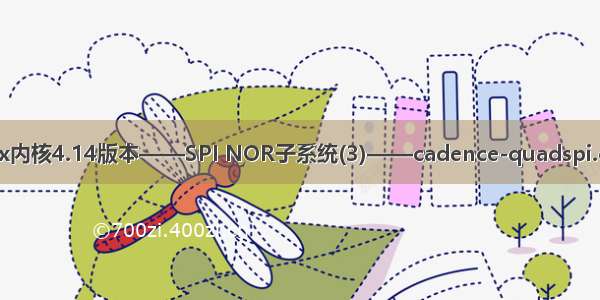
目录
1、简述
2、Gpiolib 相关数据结构分析
2.1 gpio_chip 结构
2.2 gpio_desc 结构
2.3 gpio_device 结构
3 Gpiolib 对接芯片底层
3.1 注册 GPIO 资源(gpiochip_add_data)
3.2 part1
3.2part 2
3.3part 3
4、Gpiolib 为其他驱动提供的 APIs
参考文章:GPIO子系统 - 蜗窝科技
1、简述
GPIO 资源是相对来说较为简单,而且比较通用(比如 LED 灯),而 Linux 的 GPIO 驱动属于 Linux Driver 中较为容易上手的部分,但是简单归简单,在 Linux 系统中,要使用 GPIO 资源,还是需要了解一些内容。
Linux Kernel 中对 GPIO 资源进行了抽象,抽象出一个叫做 Gpiolib 的东东,这个东东作为 GPIO 资源的管理核心存在:
中间层是 Gpiolib,用于管理系统中的 GPIO。Gpiolib 汇总了 GPIO 的通用操作,根据 GPIO 的特性,Gpiolib 对上(其他 Drivers)提供的一套统一通用的操作 GPIO 的软件接口,屏蔽了不同芯片的具体实现。对下,Gpiolib 提供了针对不同芯片操作的一套 framework,针对不同芯片,只需要实现 Specific Chip Driver ,然后使用 Gpiolib 提供的注册函数,将其挂接到 Gpiolib 上,这样就完成了这一套东西。
对于其他驱动来说,比如 LED 灯驱动,就需要用到通用的 Gpiolib 的函数来进行 I/O 口的操作。
2、Gpiolib 相关数据结构分析
先分析数据结构,Gpiolib 其实就是围绕几个数据结构在做文章,数据结构以及抽象层次清楚了,代码自然很快。
数据结构主要定义在 include/linux/gpio/driver.h 和 /drivers/gpio/gpiolib.h 中
首先看一个数据结构,叫 struct gpio_chip (include/linux/gpio/driver.h):
/*** struct gpio_chip - abstract a GPIO controller* @label: a functional name for the GPIO device, such as a part*number or the name of the SoC IP-block implementing it.* @gpiodev: the internal state holder, opaque struct* @parent: optional parent device providing the GPIOs* @owner: helps prevent removal of modules exporting active GPIOs* @request: optional hook for chip-specific activation, such as*enabling module power and clock; may sleep* @free: optional hook for chip-specific deactivation, such as*disabling module power and clock; may sleep* @get_direction: returns direction for signal "offset", 0=out, 1=in,*(same as GPIOF_DIR_XXX), or negative error* @direction_input: configures signal "offset" as input, or returns error* @direction_output: configures signal "offset" as output, or returns error* @get: returns value for signal "offset", 0=low, 1=high, or negative error* @set: assigns output value for signal "offset"* @set_multiple: assigns output values for multiple signals defined by "mask"* @set_config: optional hook for all kinds of settings. Uses the same*packed config format as generic pinconf.* @to_irq: optional hook supporting non-static gpio_to_irq() mappings;*implementation may not sleep* @dbg_show: optional routine to show contents in debugfs; default code*will be used when this is omitted, but custom code can show extra*state (such as pullup/pulldown configuration).* @base: identifies the first GPIO number handled by this chip;*or, if negative during registration, requests dynamic ID allocation.*DEPRECATION: providing anything non-negative and nailing the base*offset of GPIO chips is deprecated. Please pass -1 as base to*let gpiolib select the chip base in all possible cases. We want to*get rid of the static GPIO number space in the long run.* @ngpio: the number of GPIOs handled by this controller; the last GPIO*handled is (base + ngpio - 1).* @names: if set, must be an array of strings to use as alternative*names for the GPIOs in this chip. Any entry in the array*may be NULL if there is no alias for the GPIO, however the*array must be @ngpio entries long. A name can include a single printk*format specifier for an unsigned int. It is substituted by the actual*number of the gpio.* @can_sleep: flag must be set iff get()/set() methods sleep, as they*must while accessing GPIO expander chips over I2C or SPI. This*implies that if the chip supports IRQs, these IRQs need to be threaded*as the chip access may sleep when e.g. reading out the IRQ status*registers.* @read_reg: reader function for generic GPIO* @write_reg: writer function for generic GPIO* @pin2mask: some generic GPIO controllers work with the big-endian bits*notation, e.g. in a 8-bits register, GPIO7 is the least significant*bit. This callback assigns the right bit mask.* @reg_dat: data (in) register for generic GPIO* @reg_set: output set register (out=high) for generic GPIO* @reg_clr: output clear register (out=low) for generic GPIO* @reg_dir: direction setting register for generic GPIO* @bgpio_bits: number of register bits used for a generic GPIO i.e.*<register width> * 8* @bgpio_lock: used to lock chip->bgpio_data. Also, this is needed to keep*shadowed and real data registers writes together.* @bgpio_data:shadowed data register for generic GPIO to clear/set bits*safely.* @bgpio_dir: shadowed direction register for generic GPIO to clear/set*direction safely.* @irqchip: GPIO IRQ chip impl, provided by GPIO driver* @irqdomain: Interrupt translation domain; responsible for mapping*between GPIO hwirq number and linux irq number* @irq_base: first linux IRQ number assigned to GPIO IRQ chip (deprecated)* @irq_handler: the irq handler to use (often a predefined irq core function)*for GPIO IRQs, provided by GPIO driver* @irq_default_type: default IRQ triggering type applied during GPIO driver*initialization, provided by GPIO driver* @irq_chained_parent: GPIO IRQ chip parent/bank linux irq number,*provided by GPIO driver for chained interrupt (not for nested*interrupts).* @irq_nested: True if set the interrupt handling is nested.* @irq_need_valid_mask: If set core allocates @irq_valid_mask with all*bits set to one* @irq_valid_mask: If not %NULL holds bitmask of GPIOs which are valid to*be included in IRQ domain of the chip* @lock_key: per GPIO IRQ chip lockdep class** A gpio_chip can help platforms abstract various sources of GPIOs so* they can all be accessed through a common programing interface.* Example sources would be SOC controllers, FPGAs, multifunction* chips, dedicated GPIO expanders, and so on.** Each chip controls a number of signals, identified in method calls* by "offset" values in the range 0..(@ngpio - 1). When those signals* are referenced through calls like gpio_get_value(gpio), the offset* is calculated by subtracting @base from the gpio number.*/struct gpio_chip {const char*label;struct gpio_device*gpiodev;struct device*parent;struct module*owner;int(*request)(struct gpio_chip *chip,unsigned offset);void(*free)(struct gpio_chip *chip,unsigned offset);int(*get_direction)(struct gpio_chip *chip,unsigned offset);int(*direction_input)(struct gpio_chip *chip,unsigned offset);int(*direction_output)(struct gpio_chip *chip,unsigned offset, int value);int(*get)(struct gpio_chip *chip,unsigned offset);void(*set)(struct gpio_chip *chip,unsigned offset, int value);void(*set_multiple)(struct gpio_chip *chip,unsigned long *mask,unsigned long *bits);int(*set_config)(struct gpio_chip *chip,unsigned offset,unsigned long config);int(*to_irq)(struct gpio_chip *chip,unsigned offset);void(*dbg_show)(struct seq_file *s,struct gpio_chip *chip);intbase;u16ngpio;const char*const *names;boolcan_sleep;#if IS_ENABLED(CONFIG_GPIO_GENERIC)unsigned long (*read_reg)(void __iomem *reg);void (*write_reg)(void __iomem *reg, unsigned long data);unsigned long (*pin2mask)(struct gpio_chip *gc, unsigned int pin);void __iomem *reg_dat;void __iomem *reg_set;void __iomem *reg_clr;void __iomem *reg_dir;int bgpio_bits;spinlock_t bgpio_lock;unsigned long bgpio_data;unsigned long bgpio_dir;#endif#ifdef CONFIG_GPIOLIB_IRQCHIP/** With CONFIG_GPIOLIB_IRQCHIP we get an irqchip inside the gpiolib* to handle IRQs for most practical cases.*/struct irq_chip*irqchip;struct irq_domain*irqdomain;unsigned intirq_base;irq_flow_handler_tirq_handler;unsigned intirq_default_type;unsigned intirq_chained_parent;boolirq_nested;boolirq_need_valid_mask;unsigned long*irq_valid_mask;struct lock_class_key*lock_key;#endif#if defined(CONFIG_OF_GPIO)/** If CONFIG_OF is enabled, then all GPIO controllers described in the* device tree automatically may have an OF translation*//*** @of_node:** Pointer to a device tree node representing this GPIO controller.*/struct device_node *of_node;/*** @of_gpio_n_cells:** Number of cells used to form the GPIO specifier.*/unsigned int of_gpio_n_cells;/*** @of_xlate:** Callback to translate a device tree GPIO specifier into a chip-* relative GPIO number and flags.*/int (*of_xlate)(struct gpio_chip *gc,const struct of_phandle_args *gpiospec, u32 *flags);#endif};
gpio_chip 这个数据结构一看,很多函数指针结构,明眼人秒懂,此结构是为了抽象 GPIO 的所有操作,同时适配不同芯片的一个 common 的结构,所以,这个结构是要开出去给其他芯片进行特定的操作赋值的,比如你是 Qcom 的芯片,那么你需要实现你的这些 gpio_chip 的内容。
2.1 gpio_chip 结构
一般的,在一个芯片中,针对所有的 I/O 口都会有配置,默认状态有些是 I/O 口全部默认 GPIO 输入(稳当)。一般芯片会提供管脚复用的功能(后期的 Linux 版本中,使用 pin control 来抽象),要使用 GPIO ,则首先需要配置他为 GPIO 功能,而不是其他的服用功能。
而针对 GPIO 呢,有一些通用的特性,比如设置 GPIO 的方向,读 GPIO 的电平(输入的时候),写 GPIO 的电平(输出的时候),GPIO 作为外部中断输入,等等。
gpio_chip 的抽象,其实是对 GPIO 一组 Bank 的抽象,通常在硬件上,一个芯片对 IO 口来说,分为了很多个 Bank,每个 Bank 分为了 N 组 GPIO。
比如:1 个 SoC 将 I/O 分为了 4 个 Bank:
Bank 1:GPIOA ~ GPIOB
Bank 2:GPIOC ~ GPIOD
Bank 3:GPIOE ~ GPIOF
Bank 4:GPIOG ~ GPIOH
然鹅,每个 Bank 都有 N 组寄存器来表示 GPIO 的操作,比如:
Bank 1 中,针对 GPIO A:
GPIOA_CFG 来表示对 GPIO A 的配置
GPIOA_PULL 来表示对 GPIO A 的上下拉的配置
GPIOA_DIR 来表示对 GPIO A 配置成为输入或者输出
GPIOA_DATA 来表示 GPIO A 设置为输出的时候设置为高低或者输入的时候读高低
当然,Bank 1 中 针对 GPIO B,也是一样的操作:
GPIOB_CFG 来表示对 GPIO B 的配置
GPIOB_PULL 来表示对 GPIO B 的上下拉的配置
GPIOB_DIR 来表示对 GPIO B 配置成为输入或者输出
GPIOB_DATA 来表示 GPIO B 设置为输出的时候设置为高低或者输入的时候读高低
上面说的是一个 Bank 的情况,那么芯片有好几个 Bank,所以它们都是类似的,这里不在赘述。
所以整体结构是如下所示(这里只是打个比方,有的芯片 Bank 很多,寄存器也很多):
Linux Driver Gpiolib 对他们的抽象,使用 gpio_chip 对应了一组 Bank 描述,比如 Bank ·1,用一个 gpio_chip 来抽象:
那么多个 Bank ,就用指针,或者数组来表示咯。当然这里可能说得有点不准确,gpio_chip 只是抽象了一组 Bank 的统一的接口而已。
那么对于一颗芯片底层来说,需要根据芯片手册 Datasheet,来实现这些结构的接口。
2.2 gpio_desc 结构
既然系统分为多个 Bank,每个 Bank 又由几组组成,那么每个 GPIO 实体就由一个 gpio_desc 来描述:
struct gpio_desc {struct gpio_device*gdev;unsigned longflags;/* flag symbols are bit numbers */#define FLAG_REQUESTED0#define FLAG_IS_OUT1#define FLAG_EXPORT2/* protected by sysfs_lock */#define FLAG_SYSFS3/* exported via /sys/class/gpio/control */#define FLAG_ACTIVE_LOW6/* value has active low */#define FLAG_OPEN_DRAIN7/* Gpio is open drain type */#define FLAG_OPEN_SOURCE 8/* Gpio is open source type */#define FLAG_USED_AS_IRQ 9/* GPIO is connected to an IRQ */#define FLAG_IS_HOGGED11/* GPIO is hogged */#define FLAG_SLEEP_MAY_LOOSE_VALUE 12/* GPIO may loose value in sleep *//* Connection label */const char*label;/* Name of the GPIO */const char*name;};
这个结构比较简单,可以看到,他包含了一个 gpio_device 的结构和 flag,以及 lable 和 name;
gdev 指针指向了这个 gpio_desc 所属的 gpio_device(马上描述),flag 代表了这个 GPIO 的属性状态;
看起来 gpio_chip 和 gpio_desc 应该是包含关系,但是 Kernel 中并没有直接将其两个结构联系上,而是通过另外一个结构将其联系在一起,这个结构就是 gpio_device。
2.3 gpio_device 结构
gpio_device 应该算是大内总管了(最新的内核有,Linux 3 版本的内核没有这个),如果说 gpio_chip 是对一个 Bank 的 GPIO 的硬件的具体抽象的话,那么 gpio_device 就是软件层面上对一个 Bank 的 GPIO 进行管理的单元,它的数据结构是:
enum of_gpio_flags;enum gpiod_flags;enum gpio_lookup_flags;struct acpi_device;/*** struct gpio_device - internal state container for GPIO devices* @id: numerical ID number for the GPIO chip* @dev: the GPIO device struct* @chrdev: character device for the GPIO device* @mockdev: class device used by the deprecated sysfs interface (may be* NULL)* @owner: helps prevent removal of modules exporting active GPIOs* @chip: pointer to the corresponding gpiochip, holding static* data for this device* @descs: array of ngpio descriptors.* @ngpio: the number of GPIO lines on this GPIO device, equal to the size* of the @descs array.* @base: GPIO base in the DEPRECATED global Linux GPIO numberspace, assigned* at device creation time.* @label: a descriptive name for the GPIO device, such as the part number* or name of the IP component in a System on Chip.* @data: per-instance data assigned by the driver* @list: links gpio_device:s together for traversal** This state container holds most of the runtime variable data* for a GPIO device and can hold references and live on after the* GPIO chip has been removed, if it is still being used from* userspace.*/struct gpio_device {intid;struct devicedev;struct cdevchrdev;struct device*mockdev;struct module*owner;struct gpio_chip*chip;struct gpio_desc*descs;intbase;u16ngpio;char*label;void*data;struct list_head list;#ifdef CONFIG_PINCTRL/** If CONFIG_PINCTRL is enabled, then gpio controllers can optionally* describe the actual pin range which they serve in an SoC. This* information would be used by pinctrl subsystem to configure* corresponding pins for gpio usage.*/struct list_head pin_ranges;#endif};
在这个 gpio_device 结构中,包含了 gpio_chip(对接芯片的操作集),gpio_desc(一些 GPIO 的描述);这个结构贯穿了整个 Gpiolib,因为 gpio_device 代表的是一个 Bank,一般的 GPIO 有多个 Bank,所以 Kernel 中,对这 gpio_device 的组织是由一个 gpio_devices 的链表构成(此处是多个 device,所以后面加了 s),在 gpiolib.c:
LIST_HEAD(gpio_devices);
3 Gpiolib 对接芯片底层
先聊聊 Gpiolib 是怎么对接到底层实际的驱动的。在前面的 2.1 部分讲过,底层需要对接的,其实对接的部分只有那些通用的操作,其实也就是 gpio_chip 这个玩意,所以,对接底层的部分,主要关心的是这个结构体,并且对这个结构体进行赋值的过程。
在底层对接到 Gpiolib 的时候,主要是对 gpio_chip 进行实现,然后调用 gpiochip_add 的接口,向 Gpiolib 注册你的 GPIO 。
实现的过程,主要是根据芯片手册,实现对应的 GPIO 的操作,也就是说,把寄存器操作编程成为函数,对接到这个 gpio_chip 结构体上。
gpio_chip 结构体相关的成员进行了赋值,并最终调用到了 gpiochip_add_data或者devm_gpiochip_add_data函数,将其注册到了内核的 Gpiolib 子系统。大致的流程是这样的,一些细节,可能由于版本不一致,内容有细微区别。接下来我们看看这个注册 GPIO 的函数。
3.1 注册 GPIO 资源(gpiochip_add_data)
传入的结构是 gpio_chip,也就是一个 Bank 的描述,那么实际上, CPU 的 GPIO 控制器有多个 I/O Bank,那换句话说,需要 Kernel 管理的 GPIO Bank 的部分,都需要调用这个接口,注册进内核(当然,你也可以野蛮的 Bypass);
int gpiochip_add_data(struct gpio_chip *chip, void *data);
3.2 part1
这个函数分成几次来看,先是 part 1:
/*** gpiochip_add_data() - register a gpio_chip* @chip: the chip to register, with chip->base initialized* @data: driver-private data associated with this chip** Context: potentially before irqs will work** When gpiochip_add_data() is called very early during boot, so that GPIOs* can be freely used, the chip->parent device must be registered before* the gpio framework's arch_initcall(). Otherwise sysfs initialization* for GPIOs will fail rudely.** gpiochip_add_data() must only be called after gpiolib initialization,* ie after core_initcall().** If chip->base is negative, this requests dynamic assignment of* a range of valid GPIOs.** Returns:* A negative errno if the chip can't be registered, such as because the* chip->base is invalid or already associated with a different chip.* Otherwise it returns zero as a success code.*/int gpiochip_add_data(struct gpio_chip *chip, void *data){unsigned longflags;intstatus = 0;unsignedi;intbase = chip->base;struct gpio_device *gdev;/** First: allocate and populate the internal stat container, and* set up the struct device.*/gdev = kzalloc(sizeof(*gdev), GFP_KERNEL);if (!gdev)return -ENOMEM;gdev->dev.bus = &gpio_bus_type;gdev->chip = chip;chip->gpiodev = gdev;if (chip->parent) {gdev->dev.parent = chip->parent;gdev->dev.of_node = chip->parent->of_node;}#ifdef CONFIG_OF_GPIO/* If the gpiochip has an assigned OF node this takes precedence */if (chip->of_node)gdev->dev.of_node = chip->of_node;#endifgdev->id = ida_simple_get(&gpio_ida, 0, 0, GFP_KERNEL);if (gdev->id < 0) {status = gdev->id;goto err_free_gdev;}dev_set_name(&gdev->dev, "gpiochip%d", gdev->id);device_initialize(&gdev->dev);dev_set_drvdata(&gdev->dev, gdev);if (chip->parent && chip->parent->driver)gdev->owner = chip->parent->driver->owner;else if (chip->owner)/* TODO: remove chip->owner */gdev->owner = chip->owner;elsegdev->owner = THIS_MODULE;.......................part 1 end.......................}
part 1 中,因为传入的结构是 gpio_chip,他代表了是一个 Bank,但是并没有 gpio_device 的结构,所以,在这个函数中,首先分配一个 gpio_device 的结构,并将其结构体成员的 chip ,等等进行赋值,建立起相关的结构联系。
3.2part 2
再看 part 2:
..............part 2 start..............gdev->descs = kcalloc(chip->ngpio, sizeof(gdev->descs[0]), GFP_KERNEL);if (!gdev->descs) {status = -ENOMEM;goto err_free_ida;}if (chip->ngpio == 0) {chip_err(chip, "tried to insert a GPIO chip with zero lines\n");status = -EINVAL;goto err_free_descs;}if (chip->label)gdev->label = kstrdup(chip->label, GFP_KERNEL);elsegdev->label = kstrdup("unknown", GFP_KERNEL);if (!gdev->label) {status = -ENOMEM;goto err_free_descs;}gdev->ngpio = chip->ngpio;gdev->data = data;..............part 2 end..............
part 2 中,由于 1 个 Bank不仅仅只有一个 GPIO,所以 gpio_chip->ngpio 的结构表示了这个 Bank 一共的 GPIO 个数,每一个 GPIO 使用一个 gpio_desc 表示,所以,这里分配了 ngpio 个 descs;
3.3part 3
.............part 3 start............. spin_lock_irqsave(&gpio_lock, flags);/** TODO: this allocates a Linux GPIO number base in the global* GPIO numberspace for this chip. In the long run we want to* get *rid* of this numberspace and use only descriptors, but* it may be a pipe dream. It will not happen before we get rid* of the sysfs interface anyways.*/if (base < 0) {base = gpiochip_find_base(chip->ngpio);if (base < 0) {status = base;spin_unlock_irqrestore(&gpio_lock, flags);goto err_free_label;}/** TODO: it should not be necessary to reflect the assigned* base outside of the GPIO subsystem. Go over drivers and* see if anyone makes use of this, else drop this and assign* a poison instead.*/chip->base = base;}gdev->base = base;status = gpiodev_add_to_list(gdev);if (status) {spin_unlock_irqrestore(&gpio_lock, flags);goto err_free_label;}spin_unlock_irqrestore(&gpio_lock, flags);for (i = 0; i < chip->ngpio; i++) {struct gpio_desc *desc = &gdev->descs[i];desc->gdev = gdev;/* REVISIT: most hardware initializes GPIOs as inputs (often* with pullups enabled) so power usage is minimized. Linux* code should set the gpio direction first thing; but until* it does, and in case chip->get_direction is not set, we may* expose the wrong direction in sysfs.*/desc->flags = !chip->direction_input ? (1 << FLAG_IS_OUT) : 0;}#ifdef CONFIG_PINCTRLINIT_LIST_HEAD(&gdev->pin_ranges);#endifstatus = gpiochip_set_desc_names(chip);if (status)goto err_remove_from_list;status = gpiochip_irqchip_init_valid_mask(chip);if (status)goto err_remove_from_list;status = of_gpiochip_add(chip);if (status)goto err_remove_chip;acpi_gpiochip_add(chip);/** By first adding the chardev, and then adding the device,* we get a device node entry in sysfs under* /sys/bus/gpio/devices/gpiochipN/dev that can be used for* coldplug of device nodes and other udev business.* We can do this only if gpiolib has been initialized.* Otherwise, defer until later.*/if (gpiolib_initialized) {status = gpiochip_setup_dev(gdev);if (status)goto err_remove_chip;}return 0;err_remove_chip:acpi_gpiochip_remove(chip);gpiochip_free_hogs(chip);of_gpiochip_remove(chip);gpiochip_irqchip_free_valid_mask(chip);err_remove_from_list:spin_lock_irqsave(&gpio_lock, flags);list_del(&gdev->list);spin_unlock_irqrestore(&gpio_lock, flags);err_free_label:kfree(gdev->label);err_free_descs:kfree(gdev->descs);err_free_ida:ida_simple_remove(&gpio_ida, gdev->id);err_free_gdev:/* failures here can mean systems won't boot... */pr_err("%s: GPIOs %d..%d (%s) failed to register\n", __func__,gdev->base, gdev->base + gdev->ngpio - 1,chip->label ? : "generic");kfree(gdev);return status;
在 part 3 中,base 代表了每个 Bank 的编号,将其赋值;然后通过 gpiodev_add_to_list(gdev) 将这个 gdev 挂到全局的 gpio_devices :
/** Add a new chip to the global chips list, keeping the list of chips sorted* by range(means [base, base + ngpio - 1]) order.** Return -EBUSY if the new chip overlaps with some other chip's integer* space.*/static int gpiodev_add_to_list(struct gpio_device *gdev){struct gpio_device *prev, *next;if (list_empty(&gpio_devices)) {/* initial entry in list */list_add_tail(&gdev->list, &gpio_devices);return 0;}next = list_entry(gpio_devices.next, struct gpio_device, list);if (gdev->base + gdev->ngpio <= next->base) {/* add before first entry */list_add(&gdev->list, &gpio_devices);return 0;}prev = list_entry(gpio_devices.prev, struct gpio_device, list);if (prev->base + prev->ngpio <= gdev->base) {/* add behind last entry */list_add_tail(&gdev->list, &gpio_devices);return 0;}list_for_each_entry_safe(prev, next, &gpio_devices, list) {/* at the end of the list */if (&next->list == &gpio_devices)break;/* add between prev and next */if (prev->base + prev->ngpio <= gdev->base&& gdev->base + gdev->ngpio <= next->base) {list_add(&gdev->list, &prev->list);return 0;}}dev_err(&gdev->dev, "GPIO integer space overlap, cannot add chip\n");return -EBUSY;}
接着就是设置一些 name 字段,配置中断之类的,初始化每个 desc[] 结构的 flags,最后调用:
/** By first adding the chardev, and then adding the device,* we get a device node entry in sysfs under* /sys/bus/gpio/devices/gpiochipN/dev that can be used for* coldplug of device nodes and other udev business.* We can do this only if gpiolib has been initialized.* Otherwise, defer until later.*/if (gpiolib_initialized) {status = gpiochip_setup_dev(gdev);if (status)goto err_remove_chip;}
然后,不出意外的话,返回 0;
这里说一下 gpiochip_setup_dev 调用,这个是在 Gpiolib init 的时候调用 gpiochip_setup_devs:
static int __init gpiolib_dev_init(void){int ret;/* Register GPIO sysfs bus */ret = bus_register(&gpio_bus_type);if (ret < 0) {pr_err("gpiolib: could not register GPIO bus type\n");return ret;}ret = alloc_chrdev_region(&gpio_devt, 0, GPIO_DEV_MAX, "gpiochip");if (ret < 0) {pr_err("gpiolib: failed to allocate char dev region\n");bus_unregister(&gpio_bus_type);} else {gpiolib_initialized = true;gpiochip_setup_devs();}return ret;}core_initcall(gpiolib_dev_init);
而这个 gpiochip_setup_devs 对每一个 gpio_devicecs 节点调用:gpiochip_setup_dev:
static void gpiochip_setup_devs(void){struct gpio_device *gdev;int err;list_for_each_entry(gdev, &gpio_devices, list) {err = gpiochip_setup_dev(gdev);if (err)pr_err("%s: Failed to initialize gpio device (%d)\n",dev_name(&gdev->dev), err);}}
最后到:
static int gpiochip_setup_dev(struct gpio_device *gdev){int status;cdev_init(&gdev->chrdev, &gpio_fileops);gdev->chrdev.owner = THIS_MODULE;gdev->dev.devt = MKDEV(MAJOR(gpio_devt), gdev->id);status = cdev_device_add(&gdev->chrdev, &gdev->dev);if (status)return status;chip_dbg(gdev->chip, "added GPIO chardev (%d:%d)\n",MAJOR(gpio_devt), gdev->id);status = gpiochip_sysfs_register(gdev);if (status)goto err_remove_device;/* From this point, the .release() function cleans up gpio_device */gdev->dev.release = gpiodevice_release;pr_debug("%s: registered GPIOs %d to %d on device: %s (%s)\n",__func__, gdev->base, gdev->base + gdev->ngpio - 1,dev_name(&gdev->dev), gdev->chip->label ? : "generic");return 0;err_remove_device:cdev_device_del(&gdev->chrdev, &gdev->dev);return status;}
其实就是注册了字符设备,并且添加到了 sysfs;
从注释上看,因为不知道这个 init 和我们的对接底层的驱动的 init 谁先执行到,所以用了一个变量 gpiolib_initialized 来表示当前的 Gpiolib 是不是已经完成了相关的字符设备的注册,如果是 Gpiolib 先去 init 的话,那么 gpiolib_initialized ture,芯片对接底层的部分错过 gpio_chip setup 的机会,所以需要重新调用这个 gpiochip_setup_dev 接口,反之 OK;
到这里,对接底层驱动的部分基本上 OK 了,小伙伴们需要按照自己芯片的 Specific 去做自己的 gpio_chip 结构并最终通过 gpiochip_add_data 添加到 Gpiolib 子系统中;
还有一点需要注意到的是,小伙伴们需要自行定义一些结构,来获得并表示自己 Bank 的虚拟地址等等,这样才能操作到实际的硬件寄存器(后面文章具体分析一个gpio control);
4、Gpiolib 为其他驱动提供的 APIs
4.1gpio_to_desc
4.2gpiod_put
4.3gpiod_direction_input
4.4gpiod_direction_output
















